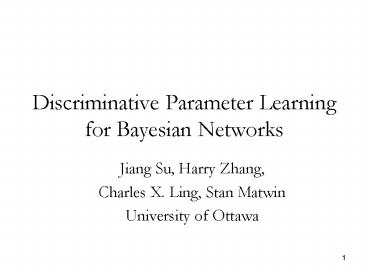Discriminative Parameter Learning for Bayesian Networks - PowerPoint PPT Presentation
1 / 15
Title:
Discriminative Parameter Learning for Bayesian Networks
Description:
information in data. DFE converges slightly slower than FE. 11. Experimental Setup ... Ada: use Ada boosting method to generate a set of Bayes. classifiers{Freund96} ... – PowerPoint PPT presentation
Number of Views:27
Avg rating:3.0/5.0
Title: Discriminative Parameter Learning for Bayesian Networks
1
Discriminative Parameter Learning for Bayesian
Networks
- Jiang Su, Harry Zhang,
- Charles X. Ling, Stan Matwin
- University of Ottawa
2
Introduction
- Learning Bayesian networks includes structure
and - parameter learning
- Parameter learning is an inner loop of
structure learning - An efficient and effective parameter learning
method is - required in Bayesian network learning
3
Introduction
- The traditional parameter learning method is
Frequency - Estimate (FE)
- The objective function of FE is likelihood
- The objective function of classifiers should be
- discriminative (accuracy, conditional
likelihood, etc)
4
Related Works
- Extended Logistic Regression (ELR) performs
better - than FEGreiner2002
- use FE to learn plug-in parameters
- conjugate gradient and line search
- cross tuning
- Gradient descent methods are computationally
- expensive in structure learning
- Friedman1997, Grossman2004
5
Frequency Estimate
- An example
Smoke Gender
N F
N F
Y F
6
Frequency Estimate
Smoke Gender
N F
N F
Y F
Smoke Gender
1 1
1 1
1 1
- Frequency information in data
- The frequency of SmokeN or Y equals to the
frequency of - GenderF
- The frequency of SmokeN is not greater than the
frequency of - GenderF
- Frequency information offers constraints during
- parameter learning
7
Discriminative Frequency Estimate
- Idea discriminatively count the frequencies in
data - Example
8
Discriminative Frequency Estimate
Smoke Gender
N F
N F
Y F
Smoke Gender
0.5 0.5
1 1
0.7 0.7
- Frequency information in data
- The frequency of SmokeN or Y equals to the
frequency of - GenderF
- The frequency of SmokeN is not greater than the
frequency of - GenderF
9
Comparisons
The matrix from different
algorithms
Gradient Descent
FE
DFE
Smoke Gender
0.1 0.8
0.5 0.1
0.7 0.3
Smoke Gender
1 1
1 1
1 1
Smoke Gender
0.5 0.5
1 1
0.7 0.7
10
Discriminative Frequency Estimate
- Example a dataset with 3 training instances, and
1 test instance - The predictions from FE and DFE are influenced
by the frequency - information in data
- DFE converges slightly slower than FE
11
Experimental Setup
- 33 UCI datasets (2 classes, discretization,
missing value) - Parameter learning methods
- FE frequency estimate
- DFE discriminative frequency estimate
- ELR a gradient descent method Greiner2002
- Ada use Ada boosting method to generate a set
of Bayes - classifiersFreund96
- Structure learning methods
- HGC hill-climbing search algorithm (2 parents)
12
Experiments-accuracy
- DFE performs competitively with ELR, and both of
- them are better than FE and Ada
- Structure learning improves the performance of
Bayes - classifiers.(HGCFEgtNBFE)
- NBELRHGCFE, HGCDFENBDFE
13
Experiments-convergence
- Training Time DFE is 250,000 times faster than
ELR - Small datasets with strong dependencies require
more than 1 - iteration (vowel, 200 instances, 4 iterations)
- Overfitting training and test data accuracy are
similar and - increased training effort does not change the
accuracy
Solid NBDFE in training data Dotted NBDFE
in test data
14
Experiments-learning curve
- Generative parameter learning does not have
advantage over - discriminative parameter learning in small
training data
Solid NBFE Dotted NBDFE Dash NBELR
15
Conclusions
- A parameter learning method for Bayesian
network classifiers - competitive with the gradient descent method in
accuracy - computationally efficient
- Insensitive to the overfitting problem
- simple to implement

